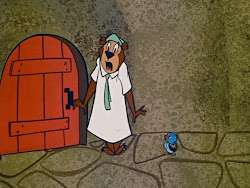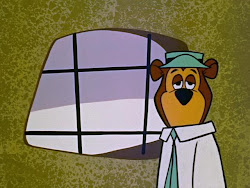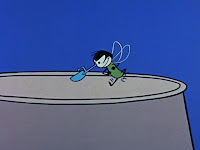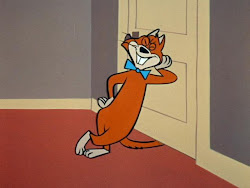 Produced and Directed by Bill Hanna and Joe Barbera.
Produced and Directed by Bill Hanna and Joe Barbera.Credits: Animation – Ken Muse, Mike Lah (uncredited); Layout – Dick Bickenbach; Backgrounds – Bob Gentle; Dialogue and Story Sketches – Charlie Shows and Dan Gordon; Titles – Art Goble; Production Supervision – Howard Hanson.
Cast: Jinks, Dixie - Daws Butler; Pixie - Don Messick.
Episode: Huckleberry Hound Show K-009, Production E-17, First aired: week of Monday, November 24, 1958.
Plot: Dixie pretends to be a ghost after Jinks bashes him with a coal scuttle. A frightened Jinks acts as a slave to Pixie until he finds out the truth and tries the ghost bit himself.
Daws Butler and Charlie Shows save this cartoon. Because the clean-up and painting work sure don’t.
People decry Hanna-Barbera’s original product for being devoid of animation and full of short-cuts. That’s understandable, given the fact they were created cheaply for television. Unfortunately, the low budgets apparently meant glaring errors couldn’t be fixed by the time the finished artwork was sent to the camera.
 This cartoon has a bunch of examples. What happened to Pixie’s neck? Has he got some weird form of swelling that only affects cartoon mice? The ink-line for his head isn’t there. There’s another head-in-the-hole shot where there’s a mousey grey where there should be a wall.
This cartoon has a bunch of examples. What happened to Pixie’s neck? Has he got some weird form of swelling that only affects cartoon mice? The ink-line for his head isn’t there. There’s another head-in-the-hole shot where there’s a mousey grey where there should be a wall.The most glaring errors are in this sequence where Jinks’ arm continually passes his mouth when he pokes Dixie, but you can see his mouth through his hand. And, for a second, someone got the instructions screwed up and Jinks changed hands and lost his mouth for a few frames.


Setting that aside, it’s still a charming cartoon. The writing shows a nice relationship between between the mice and the cat. Sure, they’re playing their assigned roles in nature, but the adversaries actually care about each other. And Daws has great fun with the script, infusing extra syllables and pulling off goofy emphasis, as he is apt to do, which makes him a joy to hear.
 Our cartoon starts with the mice roller-skating past the same window ten times before Jinks removes a furnace vent grate on the floor and down they go. An attempt to run away results in Pixie escaping, but Dixie is bopped with a coal scuttle.
Our cartoon starts with the mice roller-skating past the same window ten times before Jinks removes a furnace vent grate on the floor and down they go. An attempt to run away results in Pixie escaping, but Dixie is bopped with a coal scuttle. I really like the triangular shapes on Jinks here; I’d have to check if Muse was the only animator who gave him the shape of teeth you see here. And Bick and Bob augment the background with some geometrical art.
I really like the triangular shapes on Jinks here; I’d have to check if Muse was the only animator who gave him the shape of teeth you see here. And Bick and Bob augment the background with some geometrical art. It’s at this point where Jinks engages in the sloppy cartoon-work aforementioned then deposits the “dead” Dixie under a plant in a flowerpot on the window sill. You’ll notice in this shot, there’s a window in the background, but when they come back to it after the frames of sausage-neck Pixie (see above), the background’s different. Incidentally, I don’t know what happened with Don Messick’s voice, but during this bit Pixie sounds like the mouse professor from Little Bird-Mouse; the pitch is too low.
It’s at this point where Jinks engages in the sloppy cartoon-work aforementioned then deposits the “dead” Dixie under a plant in a flowerpot on the window sill. You’ll notice in this shot, there’s a window in the background, but when they come back to it after the frames of sausage-neck Pixie (see above), the background’s different. Incidentally, I don’t know what happened with Don Messick’s voice, but during this bit Pixie sounds like the mouse professor from Little Bird-Mouse; the pitch is too low.Jinks is worried he’s killed Dixie, so the mice conspire to scare him some more by putting a sheet on the southern mouse so he can pretend he’s a ghost. Pixie squeaks a door, rattles some chains, then rolls up a window shade as Jinks does this great shake-take. And like you’ll find in most early H-B cartoons, the take is made up of two frames alternated in a cycle in lieu of full animation. You can make an animated .gif of these and create your own Hanna-Barbera cartoon; I’ve tried it and may post them later.


This whole scene, including the take, is by Mike Lah, who takes over the animation after the sheet-clad Dixie leaves the mousehole (Dixie puns “Here ghosts” for “Here goes”). Muse is back when Jinks is in the chair saying “I’ll probably get the hot seat for this.” You can tell it’s Lah by the wide-eyed look he gives Pixie (and there’s no tongue as the mouse’s mouth moves on his face during dialogue) and the joint eyes and jagged teeth on Jinks. Lah’s versions of the characters tend to look less polished that Muse’s, but Hanna seems to have liked giving Lah scenes with fun expressions.
 There’s a lot of smear animation in Pixie and Dixie cartoons, usually when someone’s starting to run off camera. But we get some here (Muse again) as Jinks tries to figure out who’s talking to him. Then the “ghost” of Dixie appears, and the guilt-ridden cat agrees to do anything the mice say. Daws is really tremendous. I love his read of “Service with a smile!” when he leaves Pixie some chocolate cake, sounding hopeful he’s appeased the “ghost.”
There’s a lot of smear animation in Pixie and Dixie cartoons, usually when someone’s starting to run off camera. But we get some here (Muse again) as Jinks tries to figure out who’s talking to him. Then the “ghost” of Dixie appears, and the guilt-ridden cat agrees to do anything the mice say. Daws is really tremendous. I love his read of “Service with a smile!” when he leaves Pixie some chocolate cake, sounding hopeful he’s appeased the “ghost.” A nice touch is the two stray hairs on Jinks’ tail when Pixie (with all the ink-lines of his head visible this time) orders him to bark like a dog before telling him to jump out a window. Problem is the hairs keep appearing and vanishing depending on the pose.
A nice touch is the two stray hairs on Jinks’ tail when Pixie (with all the ink-lines of his head visible this time) orders him to bark like a dog before telling him to jump out a window. Problem is the hairs keep appearing and vanishing depending on the pose. Jinks looks in, sees the two mice laughing and realises Dixie isn’t dead. Daws channels the Mr. Kitzel character from the Jack Benny radio show and says “Hoo hoo HOO!” and then emphasizes the “b” as he turns to the audience and says “Ehhhh, soooo that is the way the cookie crum-bles.”
Jinks looks in, sees the two mice laughing and realises Dixie isn’t dead. Daws channels the Mr. Kitzel character from the Jack Benny radio show and says “Hoo hoo HOO!” and then emphasizes the “b” as he turns to the audience and says “Ehhhh, soooo that is the way the cookie crum-bles.”Jinks leaves behind a note (which is superfluously read for us by Dixie) and then does the ghost bit himself. Daws’ funniest reading may be right here, where Jinks lamely tries to impersonate a ghost. He manages to keep Jinks’ odd emphasis and stretched vowels while, at the same time, add the odd emphasis and stretched vowels like a clichéd ghost in a Boris Karloff movie. You try doing both. You can’t. Daws was a master.


 And since Jinks did the meeces’ bidding when Dixie was a “ghost,” the mice pledge subservience to the cat, though they can see through the lame ghost impression as well as the viewer, and (are you surprised with this?) laugh as the camera irises out.
And since Jinks did the meeces’ bidding when Dixie was a “ghost,” the mice pledge subservience to the cat, though they can see through the lame ghost impression as well as the viewer, and (are you surprised with this?) laugh as the camera irises out.Bill Loose and John Seely are credited with a whole side of “Ghost” cuts in the Capitol Hi-Q library (‘L’ series, reel 39) and while “Sublime Ghost” is used fairly often in Hanna-Barbera cartoons, and several others appeared in the Looney Tune Gopher Broke, none of them appeared here.
0:00 - Pixie and Dixie opening theme (Hanna-Barbera-Hoyt Curtin).
0:26 - LAF-21-3 RECESS (Jack Shaindlin) - Jinks bashes Dixie; thinks he's killed him.
2:01 - TC 432 HOLLY DAY (Loose-Seely) - Dixie dresses up as ghost.
2:47 – ZR-49 LIGHT EERIE (Geordie Hormel) - Mice scare Jinks; Dixie promises to haunt Jinks.
4:28 - TC 201 PIXIE COMEDY (Loose-Seely) - Jinks becomes slave to mice; jumps out window.
5:52 - L-78 COMEDY UNDERSCORE (Spencer Moore) - Mice think Jinks is dead; Jinks pretends to be ghost.
7:03 – PIXIE AND DIXIE THEME (Curtin) - Mice bow to Jinks and laugh.
7:10 - Pixie and Dixie closing theme.














































